Top News
December 4, 2015 Ryukyu Shimpo
On December 3, Kadena Town revealed aircraft noise levels had increased, including late evening and early morning flights, since F-16 fighters, which are based at Tulsa Air National Guard Base in Oklahoma, began training at Kadena Air Base. Kadena Town authorities measured noise occurrences at three points in the town and compared the results during the 28 days before and the 28 days after the training started. According to the comparison, the occurrence of noise in late evenings and early mornings since the training began increased 2.28 times as much as the pre-training period (from 142 to 324 cases). The total occurrence of noise increased to 1.39 times more than before (from 3,247 to 4,528 cases). Complaints received by the Town Office also increased from 19 cases to 44.
The two periods under comparison were from September 28 to October 25 and from October 26 to November 22. F-16 fighters flew into the Kadena Air Base on October 22 and began training on October 26.
On December 3, the Three Towns Liaison Council for Kadena Air Base, which consists of Kadena Town, Okinawa City, and Chatan Town, visited and made a complaint to the Okinawa Defense Bureau and the Ministry of Foreign Affairs’ Okinawa office. The Council requested that they do not allow F-16 fighters to operate out of Kadena Air Base and that they provide complete information about foreign fighters to the Council. The Council also visited these institutions before the training had started and requested the aircraft not to fly.
Chatan Town Mayor Masaharu Noguni, who also serves as the chair of the Council, said, “Although we indicated our disapproval of the foreign fighters in advance, F-16 fighters were deployed. It seems that the Air Force has normalized training at the Kadena Air Base.”
(English translation by T&CT and Megumi Chibana)
Go to Japanese
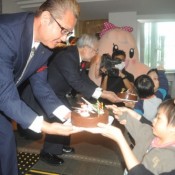
December 3, 2015 Ryukyu Shimpo
The Okinawa Confectionery Association led by Chairman Tsunemitsu Heianna gifted 300 handmade Christmas cakes to the 72 social welfare organizations in Okinawa on December 3. A ceremony was held at the Okinawa Prefecture General Welfare Center in Shuri, Naha to mark the occasion. Chairman Heianna said, “It’s a little bit early for Christmas cake, but we want people to feel happy.”
The sending of cakes started in 1975 as a year-end charity campaign, and marks its 37th anniversary this year. To date, 8,444 cakes have been sent as gifts, at an equivalent monetary value of 16.7 million yen. The cakes were distributed to each organization through the Okinawa Social Welfare Council. The chairperson of the Community Chest of Okinawa, Masahide Wakugawa, commented, “We appreciate the gift during this tough time when there is a rise in costs for ingredients as well as in consumption tax.”
(English translation by T&CT and Sayaka Sakuma)
Go to Japanese
December 4, 2015 Ryukyu Shimpo
In the regular meeting of the Okinawa Prefectural Assembly on December 3, Takeshi Kinjo of the Okinawa Prefectural Government (OPG) said there is a high possibility that the remains of those who died in what used to be Ourasaki camp, which is currently located in Camp Schwab, have not been collected. Kinjo said he is reaching out to the Ministry of Health, Labour and Welfare to inspect the site.
After collecting related documents, and carrying out a hearing of those who survived, the OPG suspects the remains to have been buried in the Henoko ammunition storage area. In November, the OPG asked the ministry to inspect the area.
According to the OPG, a specific plan for investigation has not yet been concluded. If the OPG reaches an official agreement with the ministry to carry out the investigation in the area, it also needs to work with the Ministry of Defense and the U.S. military.
(English translation by T&CT)
Go to Japanese
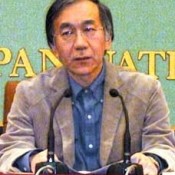
December 3, 2015 Ryukyu Shimpo
At Japan National Press Club on December 2, 61 reporters attended a lecture delivered by Tetsuya Takahashi, a professor of philosophy at the Graduate School of Arts and Sciences of the University of Tokyo, about his work Considering Relocation of Okinawa’s U.S. Military Bases Outside the Prefecture (Okinawa no beigunkichi kengai isetsu o kangaeru).
Professor Takahashi pointed out that, “Mainland Japan is the benefactor of the U.S.-Japan Security Treaty, and yet pushes the base burden onto Okinawa.” Not only this but he expressed that, “The Security Treaty was a political choice undertaken by mainland Japan, so it should bear the [base] burden,”
Takahashi raised the issue that at the time the Treaty of Mutual Cooperation and Security between the U.S. and Japan was ratified, there were no Okinawan members of the National Diet, so the Security Treaty was the political decision of mainland Japan excluding Okinawa. The result of Okinawa not having a say in the political decision-making is that although Okinawa only makes up 0.6% of Japan’s land area, 73.8% of military facilities used exclusively by the U.S. military came to be concentrated in Okinawa. Takahashi said that, “The current execution of the Security Treaty is causing fundamental inconsistencies. The discriminatory state of affairs contradicts democratic principle.”
Takahashi said, “There are movements for [the mainland] to accept bases emerging in Osaka and Fukuoka. I want the media to report citizens’ movements, and open an outlet for public opinion,” extending his request to those gathered at Japan National Press Club.
(English translation by T&CT and Erin Jones)
Go to Japanese
December 3, 2015 Ryukyu Shimpo
It was a moment that will go down in Okinawa’s history. Each and every one of the governor’s words was a perfect expression of Okinawans’ long-held sentiment.
Governor Takeshi Onaga appeared in court for the initial hearing in the execution by proxy lawsuit filed against him by the Japanese government after he nullified a permit needed to build a new U.S. military base in Henoko. The governor argued the legality of his nullification and, describing the modern history of Okinawa, made a direct criticism of the utter injustice of building a new base here. We wish to honor his courage and conviction.
As Governor Onaga declared in his statement, it is doubtful that a country that cannot ensure human rights, peace, and democracy for its own citizens can claim to share universal values with the rest of the world. This is at the heart of the ongoing lawsuit.
History repeats itself
Governor Onaga questioned, “Do local autonomy and democracy really exist in Japan? Can the current U.S.-Japan security arrangement in which the base burden is overwhelmingly borne by Okinawa prefecture really be considered normal?” He called for a verdict from the court that would open up the future for Okinawa and for Japan.
We could not help but be moved by his words. It is like déjà vu: finding ourselves standing once again in the same spot as history is repeated.
“I can only hope for a verdict that fully appreciates the past and present of the Okinawan people who have suffered the oppression of military bases as the principles laid forth in the constitution are neglected. I hope for a verdict that reflects the spirit of ensuring fundamental human rights and local autonomy, and that opens up possibilities for the future of Okinawa, so that young people are able to have hopes and dreams.”
These could easily be mistaken for Governor Onaga’s words. In reality, they are the words of then-governor of Okinawa Masahide Ota, spoken before the grand bench of the Supreme Court in July of 1996.
The suit in 1996 was filed against then-governor Ota by the government of Japan to force him to provide a proxy signature in place of landowners who refused to lease their land to be used for U.S. military bases. Then, as now, Japan’s prime minister took the astonishing step of suing a prefectural governor. We are faced with the fact that nothing has changed as Okinawa is once again forced to demand fundamental human rights, democracy, and local autonomy—the bare minimum rights every democratic nation is obligated to guarantee for its people.
Indeed, not only has the situation not improved, it has worsened. In the past, Japanese society had a deep awareness of Okinawa’s history of suffering. Now, however, when Okinawans make an objection to the Japanese government, we are criticized directly and indirectly of impertinence.
Just a few days ago, a city council member from Sumoto in Hyogo prefecture, supposedly a representative of the people, wrote publicly that citizens joining in protests against the new base construction should be “kicked out of the way” by the police. A respected prefectural official from Gifu prefecture went so far as to write publicly: “Idiotic Okinawan people, shut up. We are going to proceed unfazed with the Henoko relocation.”
The Japanese government’s inconsistencies
Given the above comments, Governor Onaga’s statement was significant.
People who write such things have adopted the notion that Okinawans are only able to get by financially thanks to the bases, and should thus tolerate them in silence; or that Okinawans should keep their mouths shut because they are receiving massive funds from the Japanese government. Governor Onaga, however, used numbers to prove that far from being a boon, the bases are actually the biggest obstacle to economic growth in Okinawa. He proved it is an utter misconception to think that the “Okinawa promotion budget” is a special budget providing Okinawa with 300 billion yen above and beyond what any other prefecture receives. He further corrected the misunderstanding that the U.S. Marines would be unable to function outside of Okinawa, using the words of former and current defense ministers.
In Okinawa, it is common knowledge that the “base economy,” “benefits” from generous fiscal subsidies, and the “deterrent” effect of the Marines are nothing but myths. These myths are still widely believed in the rest of Japan, however. By countering these myths during a court trial that has drawn the attention of the Japanese people, Governor Onaga has conveyed their fictitious nature nationwide.
In response to Okinawa’s argument that the concentration of U.S. bases in Okinawa lacks any rationale from a military perspective, the Japanese government countered that “Mr. Onaga is merely a prefectural governor.” In other words, they claim that any decisions related to national security are beyond the competence of a mere governor. On the other hand, in order to file a complaint against the governor’s administrative actions, the Defense Bureau, a government agency, claimed to be a “private person” and a mere “business entity.” The government’s claims are utterly inconsistent.
The Naha branch of the Fukuoka High Court must take a hard look at who is really on the side of justice. We hope we are right to believe in the fairness of Japan’s judicial system, the alleged “bastion of human rights.”
(Translation by T&CT and Sandi Aritza)
Go to Japanese

November 19, 2015 Ryukyu Shimpo
On November 7 and 8, Japan International Cooperation Agency (JICA) held the Okinawa International Cooperation and Exchange Festival 2015 at the Okinawa International Center in Maeda, Urasoe. JICA’s interns, learning about technology from all over the world, and about 30 international cooperation and exchange associations in Okinawa ran booths.
Mabel Dies, an intern from El Salvador who set up a booth to introduce Latin American culture, said, “I want to introduce the beauty of volcanoes, the ocean, and other nature from my country.”
Nana Oshiro, 18, took part with her 14-year-old sister Yumika in a program to talk to people from different countries and listen to their greetings in different languages. She said, “I had so much fun seeing people from all over the world because I have no opportunity to meet such people in my everyday life. They were all friendly and I want to visit many different countries in the future.”
In the center’s dining hall, international dishes from a number of countries were served. And multinational food stands lined up outside, so visitors were able to taste various foreign foods. Mexican and Balinese dance were also performed in the gymnasium.
(English translation by T&CT, Hitomi Shinzato)
Go to Japanese
November 29, 2015 Ryukyu Shimpo
The Okinawa Prefectural Board of Education designated 17 pieces of earthenware and stone implements found on the shoreline within Camp Schwab as Cultural Properties. These items are somewhere between 800 and 2000 years old.
The pieces were discovered at the planned site in Henoko, Nago, for land reclamation toward construction of a replacement facility for U.S. Marine Corp Air Station (MCAS) Futenma. This was the first time that assessments took place in the area, and over a 9-day period of surface-level examination Cultural Properties were unearthed. There is a potential that more Cultural Properties will be found. Therefore, based on the Law for the Protection of Cultural Properties, the site should be thoroughly investigated.
In Battle of Okinawa 70 years ago, not only precious human life but also valuable heritage were lost to us. Land was forcibly seized by use of bayonets and bulldozers, and American bases were built. Up to the present local government has been unable to freely enter US military base compounds, and investigations into historic sites have not been sufficiently conducted. There have probably been cases in which the process of constructing US bases destroyed historic artifacts. It is also likely that valuable heritage is buried on the bases.
The Nago City Board of Education is appealing to the Prefectural Board of Education to designate the whole region in which the earthenware and implements were found as a historic site where relics are scattered, and is promoting a survey of the pieces found, including an investigation into their relationship with artifacts previously discovered within Camp Schwab.
According to the Law for the Protection of Cultural Properties, if a place is designated as a historic site, it becomes compulsory to excavate in the region. Should vestiges or earthenware that suggest the area may host historic ruins be found, a detailed, dedicated survey will be conducted. Until this survey is completed, construction work that could alter the terrain is prohibited. Mayor of Nago City Susumu Inamine said that he will move forward as procedures under the Law for the Protection of Cultural Properties dictate.
As for officials of the Japanese government, Minister of Defense Gen Nakatani voiced the desire to “respond appropriately in accordance with related laws.” The Law for the Protection of Cultural Properties should be included as related law. If Japan wishes to respond justifiably as a country that acts under rule of law, as Chief Cabinet Secretary Yoshihide Suga claims it is, then it will suspend relocation work until the dedicated survey is completed. We want the stance of the Government of Japan when dealing with this situation to follow Prime Minister Shinzo Abe’s resolution of domestic Japanese law being firmly upheld within base compounds.
A stone that may have been used as an anchor on a Chinese or Ryukyuan ship during the Middle Ages was discovered back in February at the same place as the earthenware and stone implements. Up to now a grouping of 7 spots containing expansive and notable historic ruins have been found. There is sufficient likelihood that more artifacts and historic sites will be discovered there.
We have the responsibility to pass our heritage on to our children and grandchildren. We wish to work hard to carry out our duty to them.
(English translation by T&CT and Erin Jones)
Go to Japanese
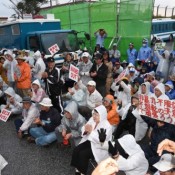
December 2, 2015 Ryukyu Shimpo
The Japanese government has sued to override Okinawa Governor Takeshi Onaga’s revocation of a landfill permit to build a new U.S. base in Henoko. A court opening session of oral proceedings was held on December 2 at the Naha branch of Fukuoka High Court. During a rainy morning, about 500 citizens protesting against the new base construction staged a sit-in. The protesters voiced strong support for Governor Onaga.
The sit-in was part of the weekly “Wednesday Mass Protest Rally.” Usually, riot police remove the protesting citizens before 7 a.m to allow construction trucks to enter the base. However, the trucks entering the base and the mobilization of the police officers were not seen. The protesters danced the kachashi for joy.
Hiroji Yamashiro, the director of the Okinawa Peace Movement, who leads the protest rally, said, “Let’s confirm that we are winning the battle against the central government. We now realize that if a lot of people gather in front of the gate, we can stop the construction. We need to hold more huge protest rallies, in addition to Wednesdays.”
Eighty-six-year-old Fumiko Shimabukuro, a regular member of protest activities against the relocation facility, said, “It is not right that the Japanese government sued the prefectural government. Governor Onaga made the right decision. He can stand up to the Japanese government’s challenge because there is nothing to hide.”
(English translation by T&CT)
Go to Japanese
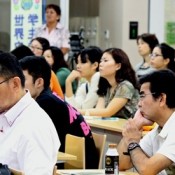
November 29, 2015 Ryukyu Shimpo
A group of young descendents of Okinawan emigrants gathered for the 1st World Uchinanchu Students Summit held by the World Youth Uchinanchu Association Hokubu Branch on November 22 at Meio University, Nago. About 100 participants, including 30 young people who are currently visiting the prefecture for training programs and who are descendants of Okinawan emigrants, discussed the history of immigrants in their respective adopted countries and future collaborations. The participants envisioned a future in which “Uchinanchu” (Okinawans) in and out of the country work together for development.
This was the first event to gather together emigrants’ descendants from different training programs in different municipalities in Okinawa.
The participants from the emigrants group, made up of people from five countries in South and North America, reported on their own immigrant society in their respective countries. Two participants from Peru, 21-year-old Andre Arakaki who studies at Meio University and 28-year-old Yukio Higa who currently works as a trainee in Chatan, introduced the nature and food culture in their country. They also explained how the Okinawan association in their country works to pass on its cultural inheritance in activities such as mending sanshin.
The representative of the Hokubu branch, Andres Higa, talked about how a sense of connectedness among Uchinanchu from different countries has been strengthening through events like the World Youth Uchinanchu Festival. The festival started in 2012, and Higa further said, “A cultural renaissance for Uchinanchu is happening.”
(English translation by T&CT and Sayaka Sakuma)
Go to Japanese
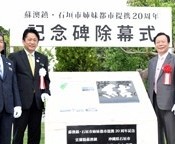
November 21, 2015 Ryukyu Shimpo
Ishigaki City and Su’ao Township in Yilan, Taiwan celebrated 20 years of sister-city relationship this year. On November 6, at Ishigaki Shinei Park, there was an unveiling ceremony for an inscribed monument with the kanji, or Chinese character, “yui”, which means bonding, to commemorate the history of the relationship. Officials attending the ceremony promised to continue to deepen the friendship and exchange.
The inscription was written by Nanryu Chihara, a well-known calligrapher and recipient of Ishigaki City Citizen’s Honor Award.
Looking back on his own childhood when he escaped the war and moved to Taiwan for safety, Chihara said, “I have a deep emotional attachment. I wrote the character boldly wishing a firmer bond between Ishigaki and Taiwan. I hope the exchange between the two thrives.“
Ishigaki City Mayor Yoshitaka Nakayama said, “Yui implies our feeling for mutual help and development. We hope to promote our relationship.”
In September, Mayor Nakayama visited Su’ao and signed a memorandum to promise the collaboration and promotion of economy, culture, tourism, and education. For the unveiling ceremony, a delegation led by Mayor Chen Jinlin from Su’ao visited Ishigaki Island and took part in the Ishigaki Island Festival, which was held on November 7.
At the ceremony, Chen said, “I hope to start another page of the history.”
(English translation by T&CT and Megumi Chibana)
Go to Japanese
December 2, 2015 Ryukyu Shimpo digital edition

In the struggle over the planned construction of a new base in Henoko, Nago as part of the relocation of U.S. Marine Corps Air Station Futenma, the Minister of Land, Infrastructure, Transport and Tourism has filed a lawsuit demanding suspension of execution of Governor Takeshi Onaga’s order to nullify the Henoko land reclamation permit, as well as demanding the right to authorize the land reclamation in lieu of the governor. At 2:00 p.m. on December 2, the initial hearing for the lawsuit began at the Naha branch of the Fukuoka High Court (presiding judge Toshiro Tamiya).
Governor Onaga, the defendant, made his statement before the court, touching on the history and current situation of Okinawa’s excessive burden of military bases and saying he hopes for a judgement that will open up the future for Okinawa and Japan.
Governor Onaga explained the history of forced land seizure to build U.S. military bases in Okinawa and emphasized that currently, the U.S. military bases pose the primary obstacle to economic development in Okinawa. He questioned whether the Futenma base could really be left in its current location in the event that the Henoko base cannot be built.
The governor further spoke about the state of local autonomy and democracy in Japan, arguing that the issues at stake in the trial exceed the question of legal validity of his nullification of the land reclamation permit based on the Public Waters Reclamation Law.
Governor Onaga entered the Naha branch of the Fukuoka High Court at 1:35 p.m. on December 2 to give his statement.
(English Translation by T&CT and Sandi Aritza)
Go to Japanese







 Webcam(Kokusai Street)
Webcam(Kokusai Street)


